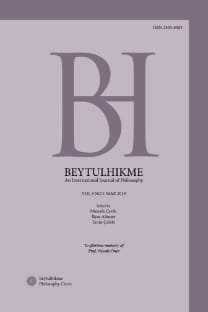Erken grek felsefesinde birlik arayışı
Bu yazının amacı, iki farklı birlik arayışının erken dönem Grek felsefesinin kavramsal gelişimi üzerindeki etkisinin nedenlerini açıklamaktır. Bu yazıda bunun amaçlanma nedeni, Grek felsefesinin diğer dönemlerinde de birlik arayışlarının şekillendirdiği kavramların etkisinin devam etmesidir. Bu etki, felsefenin tek ve ölümsüz varlığını ortaya koyma amacında görülür. Bu yazıda bu amaç için Anaximandros ve Parmenidesin arkhe ve varlık kavramları temel alınacaktır. Bu araştırmanın bu iki filozofla sınırlandırılmasının nedeni, birlik arayışının sonucu olan tek ve ölümsüz varlık kabulünün, bu iki filozofun felsefeleri temelinde şekillenmiş olmasıdır.
The search for unity in early greek philosophy
The aim of this paper is to explain the influence of two different kinds of the search for unity on the conceptual development of this era of Greek philosophy. The reason for this aim is that the influence of the search for unity continues to shape the concepts in the following stages of Greek philosophy. This influence is seen in philosophys aim of putting forward the one and only being. For this reason, this paper is based on the concepts of arche and being in Anaximandros and Parmenides. The reason for limiting this investigation with these two philosophers is that the acceptance of the one and only being as a result of the search for unity has been formed o the basis of the philosophies of these two philosophers.
___
- Burnet, J. (1968). Greek Philosophy Thales to Plato. New York: St. Martins Press.
- Classen, C.J. (1977). Anaximender and Anaximenes: The Earliest Greek Theories of Change? Phronesis, 22 (2): 89-102.
- Curd, P.K. (1991). Parmenidean Monism. Phronesis, 36 ( 3): 241-264.
- Cornford, F.M. (1993). Parmenides Two Ways. The Classical Quarterly, 27 (2): 97-111.
- Finkelberg, A. (1989). The Milesian Monistic Doctrine and the Development of Preasocratic Thought, Hermes, 117 (3): 257-270.
- Finkelberg, A. (1993). Anaximenders Conceptionof the Apeiron. Phronesis, 38 (3): 229-259.
- Finkelberg, A. (1998). On the History of Greek Kosmos. Harvard Studies in Classical Philology, 98: 103-136.
- Gurtrhrie, W.K.C. (1952). Presocratic World Picture. Harvard Theological Review, 45 (2): 87-104.
- Kranz, W. (1984). Antik Felsefe (çev. S.Y. Baydur). İstanbul: Sosyal Yayınlar.
- Kirk, G.S. (1961). Sense and Common-Sense in the Development of Greek Philosophy. The Journal of Hellenic Studies, 81: 105-117.
- Long, A.A. (1963). The Principles of Parmenides Cosmogony. Phronesis, 8 (2): 90-107.
- Mackenzie, M.M. (1982). Parmenides Dilemma. Phronesis, 27 (1): 1-12.
- Nietzsche, F. (1985). Yunanlıların Trajik Çağında Felsefe (çev. N. Hızır). BFS Yayınları.
- Thilly, F & Wood, E. (1964). A History of Philosophy. New York: Holt, Rinehart, and Wiston Inc.
- ISSN: 1303-8303
- Başlangıç: 2011
- Yayıncı: Mustafa Çevik
Sayıdaki Diğer Makaleler
Hayy bin yakzân'ın çevirmeni olarak spinoza
Panteizm ve panenteizm tartışmaları arasında spinoza
Erken grek felsefesinde birlik arayışı
The first cause' in hume's philosophy
Spinoza felsefesinin etkileri: Spinozacılığın farklı dönem ve alanlardaki yansımaları
